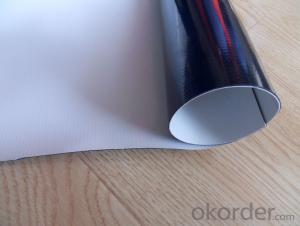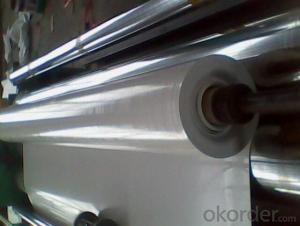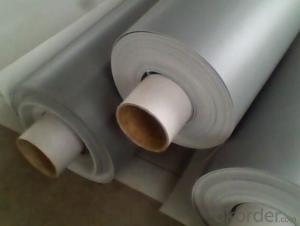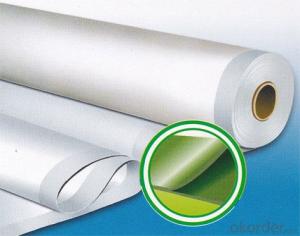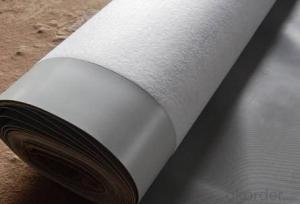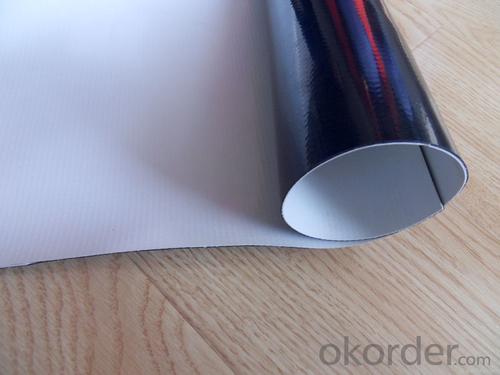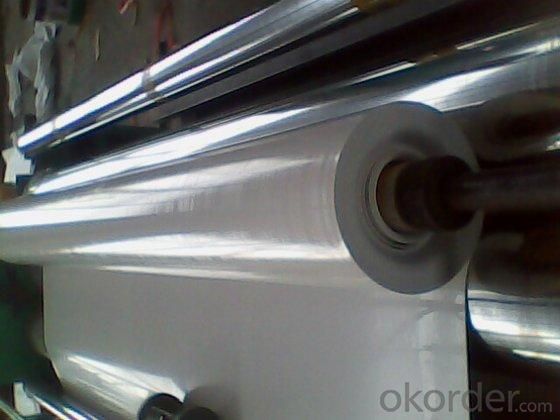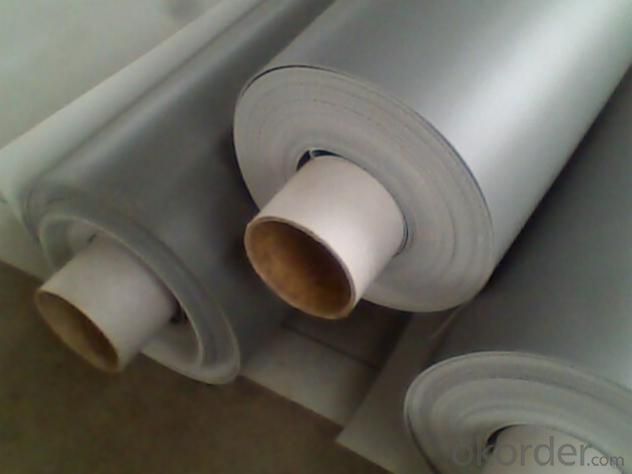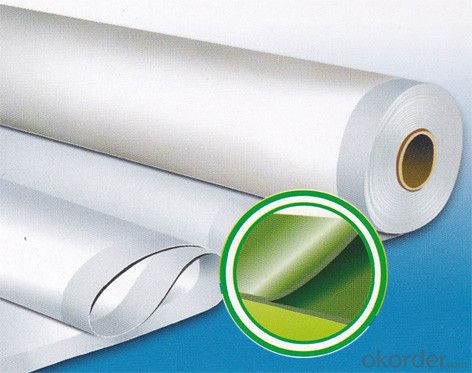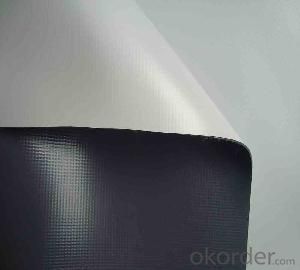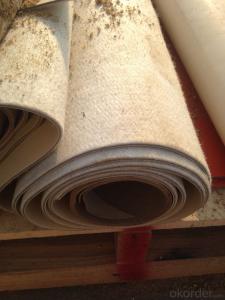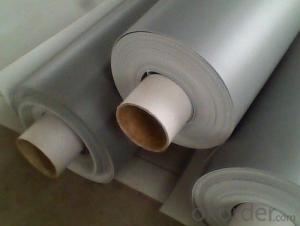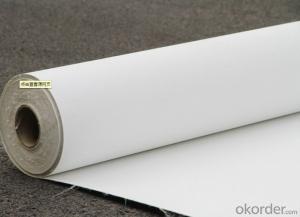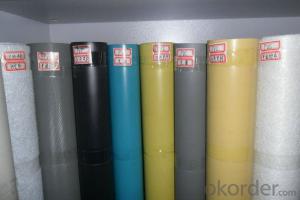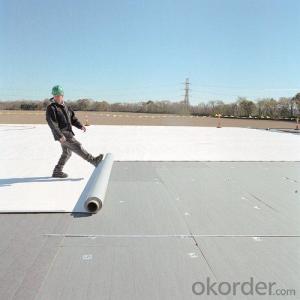PVC Waterproofing Membrane with Eco-friendly Material
- Loading Port:
- Shanghai
- Payment Terms:
- TT OR LC
- Min Order Qty:
- 20000 m²
- Supply Capability:
- 5000000 m²/month
OKorder Service Pledge
OKorder Financial Service
You Might Also Like
PVC Waterproofing Membrane with Eco-friendly Material
Product Description of PVC Waterproofing Membrane with Eco-friendly Material:
PVC Membrane Waterproof /Waterproofing membrane For Roof is a new polymer waterproof membrane. The PVC Membrane Waterproof /Waterproofing membrane For Roof raw material is polyvinyl chloride resin, mixed with plasticizer, filler, antioxygen, ultraviolet absorber and other auxiliaries.
Thickness: 1.2mm/1.5mm/1.8mm/2.0mm
Width:2050mm
Length:20m( Special specifications can be customized)
Size: 2.05mx20m
Color: white/grey, or any other colors.
Features of PVC Waterproofing Membrane with Eco-friendly Material:
1. Excellent anti-aging property.
2. Puncture- resistant.
3. Welding construction,
4. High tensile strength, good elongation, good dimensional stability.
5. Good plasticity.
6. It has self-extinguishing from fire property.
7. Materials surface is smooth, fast color, stain resistance.
8. More wide, Wastage become less when being used.
Classification of PVC Waterproofing Membrane with Eco-friendly Material:
1. N: Homogeneous PVC membrane
2. L: PVC membrane with fabric backing
3. W: Reinforced PVC membrane
Advantage of PVC Waterproofing Membrane with Eco-friendly Material:
1.) Mixing automation. Apply automatic temperature control automatic time control and automatic feed control.
2.) Extrusion equipment uses twin screw coextrusion. Screw temperature uses computer automatic temperature control system.
3.) Handpiece uses large width didhead extrusion equipment.
4.) Sophisticated three-roller calender equipment. The space between equiment is controlled by automation system.
Technical Data of PVC Waterproofing Membrane with Eco-friendly Material:
No. | Item | Model Ⅱ | |
1 | Tensile Strength Mpa ≥ | 12.0 | |
2 | Elongation at break% ≥ | 250 | |
3 | Shrinkage rate % ≤ | 2.0 | |
4 | Flexibility at low temperature | No crackle at -25oC | |
5 | Water tightness | Watertight | |
6 | Puncture resistance | Watertight | |
7 | Heat aging treatment | Appearance | Free from bubble, crack, cohesion and void |
Change rate of tensile strength % | +20oC | ||
Change rate of elongation at break | |||
Flexibility at low temperature | No crack at -20oC | ||
8 | Chemical corrosion resistance | Change rate of tensile strength % | +20 |
Change rate of elongation at break | |||
Flexibility at low temperature | No crack at -20oC | ||
9 | Artificial weathering | Change rate of tensile strength % | +20 |
Change rate of elongation at break | |||
Flexibility at low temperature | No crack at -20oC | ||
Application of PVC Waterproofing Membrane with Eco-friendly Material:
1) All kinds of roofs, such as steel structure roof, planted roof etc.
2) Underground engineering, such as building basement, subways, tunnels, air raid shelter, etc.
3) Other projects like artificial lake, dam, water reservoir, grain storehouse, etc.
Images of PVC Waterproofing Membrane with Eco-friendly Material:
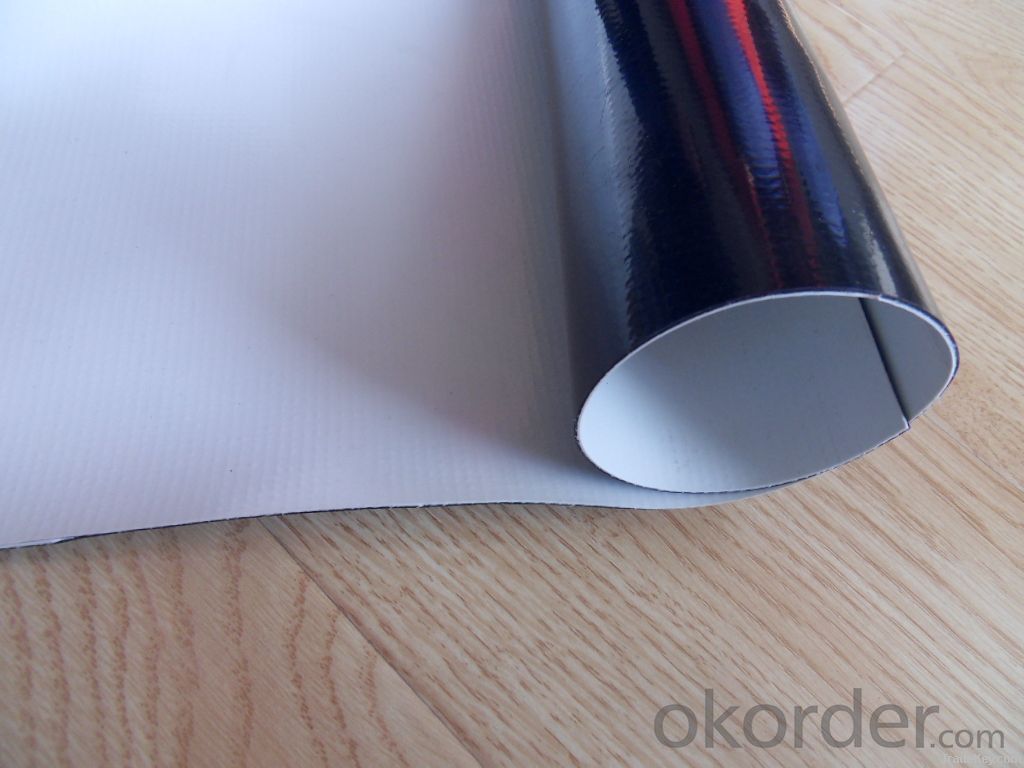
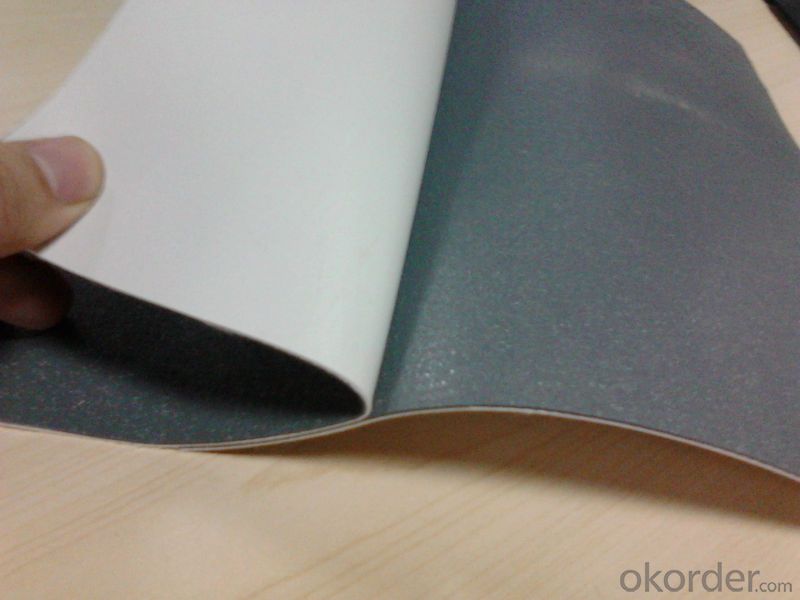
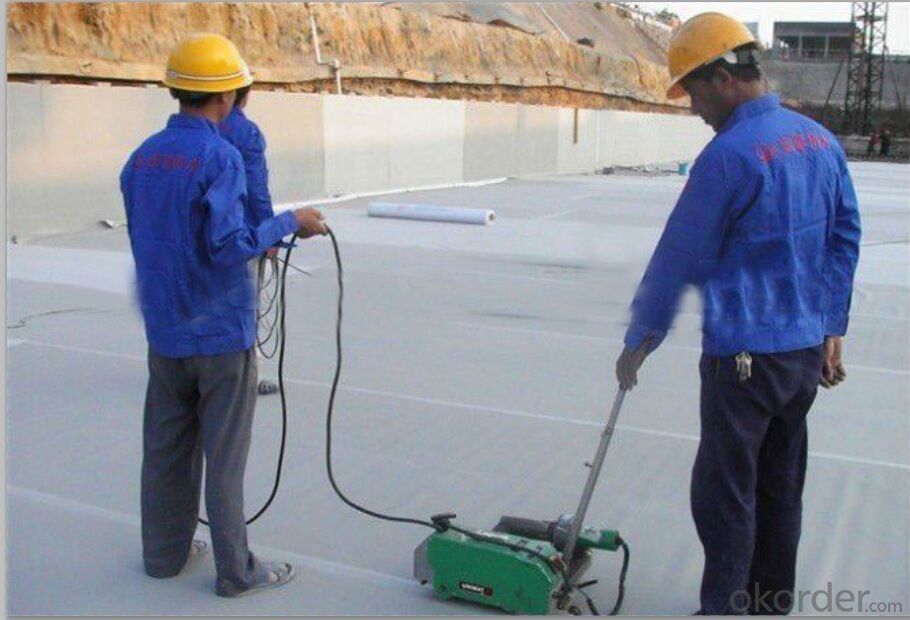
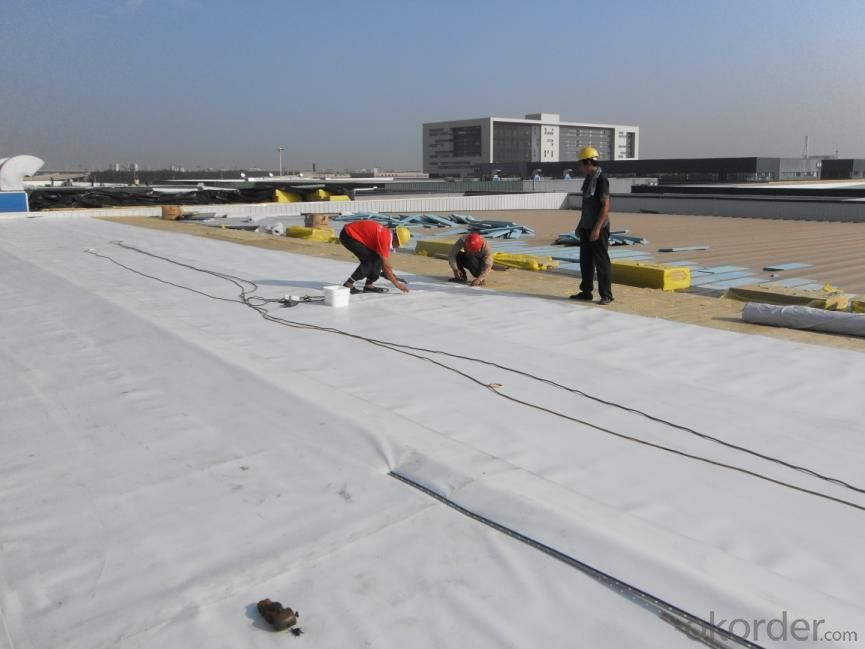
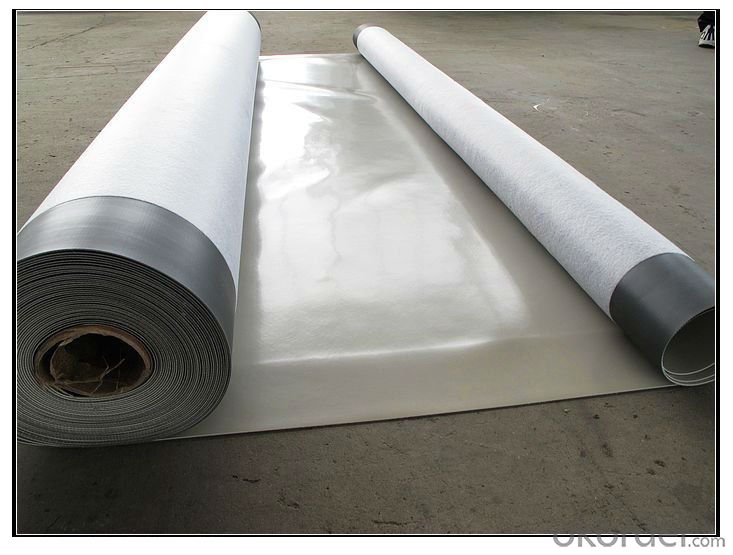
FAQ of PVC Waterproofing Membrane with Eco-friendly Material:
1. Can you produce 4m width?
Yes, no problem for us. We have four bases in China, largest one in this field.
2. How many quantity in one 20'' container for 1.2mm and 1.5mm?
480rolls, 11520m2 for 1.2mm and 400rolls, 9600m2 for 1.5mm
3. Can you provide free samples?
Yes, our samples are free, but express fees usually on buyer's account.
- Q: Can a waterproofing membrane be used for laboratories or research centers?
- Laboratories or research centers can benefit greatly from utilizing a waterproofing membrane. These membranes are specifically designed to create a barrier against water and moisture, effectively preventing any infiltration that could potentially damage the structure. Given the presence of sensitive equipment, valuable specimens, and crucial data in these environments, it becomes imperative to uphold a controlled atmosphere that is completely free from any moisture. To ensure that water leaks do not occur, a waterproofing membrane can be applied to various surfaces, including floors, walls, and roofs. This application serves to safeguard the equipment, ward off potential hazards, and preserve a safe working environment. Moreover, the presence of a waterproofing membrane aids in the prevention of mold growth, which is vital for maintaining optimal air quality within laboratories and research centers. Ultimately, opting for a waterproofing membrane is a wise decision that guarantees the integrity and functionality of laboratories and research centers.
- Q: Can a waterproofing membrane be used for a planter roof?
- Yes, a waterproofing membrane can be used for a planter roof. A waterproofing membrane is designed to prevent water from penetrating through a surface, making it an ideal choice for protecting the roof of a planter. It can effectively prevent water damage to the underlying structure, including potential leaks and deterioration caused by moisture. Additionally, a waterproofing membrane can also help to retain moisture within the planter, ensuring that plants receive adequate hydration.
- Q: Can a waterproofing membrane be used for a stadium seating area?
- Yes, a waterproofing membrane can be used for a stadium seating area. A waterproofing membrane is a material that is designed to prevent the penetration of water into a structure. It is commonly used in building construction to protect the foundation, roof, or walls from water damage. In the case of a stadium seating area, a waterproofing membrane can be applied to the concrete or other flooring material to prevent water from seeping through and causing damage. This is especially important in outdoor stadiums where rain or other forms of moisture can accumulate and potentially lead to long-term structural issues. By using a waterproofing membrane, the seating area can be protected from water damage, ensuring its longevity and safety for spectators.
- Q: Can waterproofing membranes be used on parking decks?
- Indeed, parking decks can benefit from the application of waterproofing membranes. Given their exposure to diverse weather conditions and constant vehicular movement, water infiltration and subsequent damage are potential concerns. To combat this, waterproofing membranes act as a safeguard, effectively blocking water from seeping into the structure and causing deterioration. These membranes are engineered to withstand significant loads and resist the harmful effects of automotive fluids, making them an optimal choice for parking decks. By implementing waterproofing membranes, the lifespan of the parking deck can be prolonged, minimizing the necessity for expensive repairs and guaranteeing the safety and integrity of the structure.
- Q: Can a waterproofing membrane be used as a vapor barrier?
- Yes, a waterproofing membrane can also serve as a vapor barrier. Its primary function is to prevent the passage of water or moisture, which inherently includes the ability to block vapor transmission as well.
- Q: How does a waterproofing membrane handle movement or settling of a building?
- A building's movement or settling can be accommodated by a waterproofing membrane in several ways. Firstly, the membrane is typically installed in a manner that allows it to stretch or flex as the building moves. This elasticity ensures that the membrane remains intact and continues to provide a watertight seal, even if the structure shifts or settles. In addition, waterproofing membranes often include reinforcement materials, such as fabrics or fibers, which enhance their ability to withstand movement. These reinforcements help distribute the stress or strain caused by building movement across a larger area, reducing the risk of tears or failures in the membrane. Moreover, certain waterproofing membranes are designed with built-in features that can handle significant movement. For instance, some membranes possess special "crack-bridging" properties, enabling them to span small cracks that may develop in the building's substrate due to settling. This ensures that the membrane remains effective, even if the structure sustains minor damage. In cases where a building is expected to experience significant movement or settling, specialized waterproofing systems, such as joint sealants or expansion joints, may be used in conjunction with the membrane. These systems are specifically designed to handle large or dynamic movements, providing additional protection against water infiltration. Overall, careful design and installation of a waterproofing membrane enable it to effectively handle a building's movement or settling. Its elasticity, reinforcement materials, and additional features ensure that it maintains a watertight seal, even when faced with structural shifts or settlement.
- Q: Can a waterproofing membrane be applied to curved or irregular surfaces?
- Yes, a waterproofing membrane can be applied to curved or irregular surfaces. There are flexible waterproofing membranes available in the market that can conform to various shapes and contours. These membranes are designed to be stretchable and can be manipulated to fit curved or irregular surfaces without compromising their waterproofing capabilities. It is important to choose a membrane that is specifically designed for such applications and ensure proper installation techniques are followed to ensure a watertight seal.
- Q: Can waterproofing membranes be used on bridge decks?
- Yes, waterproofing membranes can be used on bridge decks. Bridge decks are constantly exposed to harsh weather conditions, including rain, snow, and freeze-thaw cycles, which can lead to the deterioration of the concrete and steel reinforcement. Waterproofing membranes are designed to prevent water infiltration and protect the bridge deck from moisture-related damage. These membranes are typically made of flexible materials such as bitumen, PVC, or EPDM rubber, and they are applied directly onto the bridge deck surface. The waterproofing membrane acts as a barrier, preventing water from seeping into the concrete and causing corrosion of the reinforcement. It also helps to reduce the formation of cracks and extends the service life of the bridge deck. Additionally, waterproofing membranes can be combined with other protective coatings or systems to enhance their effectiveness and durability. Overall, the use of waterproofing membranes on bridge decks is a common and effective method to ensure the long-term integrity and functionality of the structure.
- Q: Whether the polyester waterproofing membrane can be used for roofing waterproofing
- In the use of polyester coil with several other waterproof materials used in conjunction with: 1, the node (lap, at the mouth) to strengthen the treatment, usually using polyurethane waterproof coating (that is, the usual "911" waterproof coating);
- Q: Are waterproofing membranes suitable for historical preservation projects?
- Depending on the specific circumstances and goals of a historical preservation project, the use of waterproofing membranes may be suitable. Waterproofing membranes are designed to prevent water infiltration and protect historical structures from moisture damage. In certain situations, historical buildings may have deteriorated or ineffective existing waterproofing systems. In these cases, modern waterproofing membranes can be a viable option to preserve and safeguard the structure. These membranes can be discreetly installed without altering the building's original appearance or architectural integrity. However, it is crucial to exercise caution when considering the use of waterproofing membranes in historical preservation projects. The potential impact on the authenticity and historical value of the structure must be carefully assessed. Some historical buildings may require specialized preservation techniques due to unique construction methods or materials, making alternative preservation methods more appropriate than using membranes. Furthermore, the long-term consequences and maintenance requirements of waterproofing membranes should be taken into account. Certain membranes may have a limited lifespan, necessitating periodic inspections and maintenance to ensure their continued effectiveness. This ongoing maintenance should be included in the preservation plan and budget. Ultimately, the decision to incorporate waterproofing membranes into historical preservation projects should be based on a thorough evaluation of the building's specific needs, characteristics, and preservation objectives. Consulting preservation experts, architects, and engineers can help determine the most suitable approach for each unique project.
Send your message to us
PVC Waterproofing Membrane with Eco-friendly Material
- Loading Port:
- Shanghai
- Payment Terms:
- TT OR LC
- Min Order Qty:
- 20000 m²
- Supply Capability:
- 5000000 m²/month
OKorder Service Pledge
OKorder Financial Service
Similar products
Hot products
Hot Searches
Related keywords
